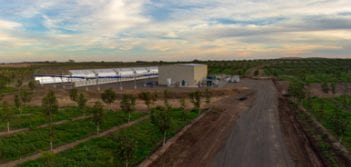Terrajoule, the Australian-led California-based start-up that proposes to use steam engine technology to help deliver cheap solar storage at a distributed level, has raised $US11.5 million in a funding round, and revealed that it is ready to deliver storage at less than $100/kWh, way cheaper than batteries.
The company has tapped funds from companies that include Air Liquide, a specialist gas producer, and investment firm New Enterprise Associates, as well as a bunch of individual investors including Australia’s Craig Winkler, the founder of accounting software company MYOB.
It will use the money for the next stage in the rollout of its technology, which it claims to be a breakthrough because it can deliver on-demand solar power to businesses at a cost five times below the cost of battery technology, and without degradation from life cycles.
As RenewEconomy wrote in its profile of the company last month, the company is planning on volume production of its technology in 2015. It has already teamed up with solar power systems supplier JKB Energy, and Roush Industries, a leading developer of automotive and energy systems.
It is targeting systems from 100kW to 20MW that operate 24/7, and promises a “compelling” payback for off-grid and on-grid power. Its initial focus will be industrial and agricultural sectors, particularly in those locations which have expensive or inadequate grids, or where waste heat can be used to improve the efficiency of industrial operations.
 The first pilot project was installed in an irrigated almond farm in California’s Central Valley (pictured), and the company sees a huge demand among the irrigated farm community, particularly in the solar-rich south west of the US, and in Australia. Irrigated farm operations in Australia are watching with interest, because if the company delivers what it says it can, it will be an attractive proposition.
The first pilot project was installed in an irrigated almond farm in California’s Central Valley (pictured), and the company sees a huge demand among the irrigated farm community, particularly in the solar-rich south west of the US, and in Australia. Irrigated farm operations in Australia are watching with interest, because if the company delivers what it says it can, it will be an attractive proposition.
Terrajoule says it is aiming in 2015 for a price per peak watt of $1.50 to $2.00 at a 20 per cent capacity factor, depending on system size, the strength of the solar resource (DNI) and other factors. Mostly, this is comparable to the price for a PV solar panel system (without storage) at the equivalent capacity factor.
But it says its price of net electrical storage capacity will be less than $100/kWh. This is a fraction of the cost of most battery storage technologies, and comes without cycle limitations, degradation of capacity, disposal costs, and all balance of system costs. It sees further cost falls as production is scaled up.
Terrajoule’s chief technology office Robert Mierisch searched back into the historical manuals to develop his idea of using the 300-year-old technology of a steam engine and a pressurised water tank as the means of storage and delivering electricity and/or waste heat on demand. Its proposal use a type of steam engine that has been out of service for decades, apart from tourist ferry or two, has raised eyebrows.
But Arno Penzias, from NEA Venture Partner, and Nobel Prize winner in Physics in 1978, said the company has made outstanding technological progress. “Terrajoule’s energy storage solution removes a fundamental obstacle to the next few decades of sustainable energy growth,” he said in a statement
According to Terrajoule (it now has its own website), the essential characteristic of the its system is its ability to rapidly respond to changes in load, functioning equivalently to the diesel generators it replaces, and without volatile fuel costs.
“Energy storage is based on pressurized saturated water, with 98% storage/retrieval efficiency,” it says in its press release. “Energy conversion is performed via reciprocating steam piston engines that are highly efficient across a wide range of operating power. The system generates steam through mature solar concentrator technology” (such as parabolic troughs).”
As the company explains on its website:
“Major problems are sometimes resolved with unexpected solutions. Who expected that reciprocating steam piston engines would play a major role in 21st century energy growth?
“Reciprocating steam engines powered the industrial revolution and steam itself is ubiquitous throughout industry to this day. Actually it is the phase change between steam and water that makes water a fundamental component of both life and industrial processes.
Steam is fundamental to the conversion between thermal energy and electricity, and steam piston engines built with modern automotive technology are back.”
We explained more about how it works in our profile.
Terrajoule CEO Steve Bisset said the funds would enable the company to bring the technology to global markets, although it will be careful and cautious about the pace of deployment and the markets it is targeting.
“Developing a game-changing energy storage solution is about more than technology. We’ve focused on building the right value proposition, market channels, and capital partners to build a business with global reach and scale without depending on government subsidies,” he said.
This means avoiding the need for massive capital requirements which has challenged developers of other technologies. Air Liquide, which provides specialty gases to a variety of industries, is attracted to the technology because it will help boost the efficiency and reduce the carbon footprint of its hydrogen units.








